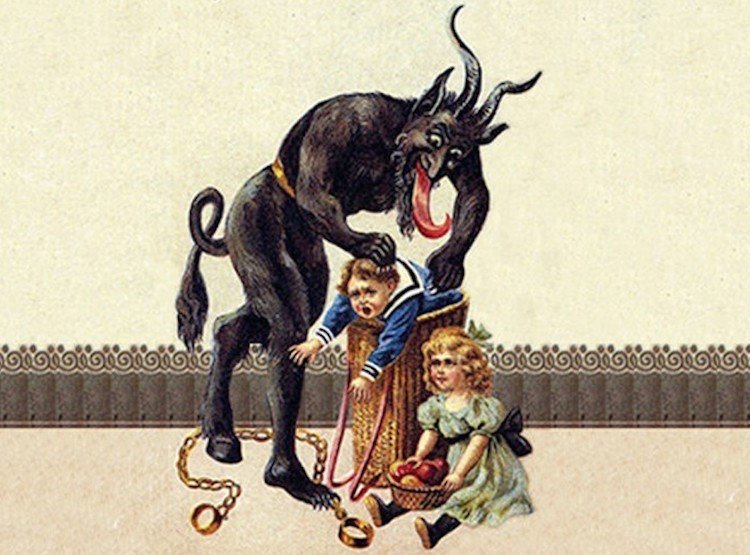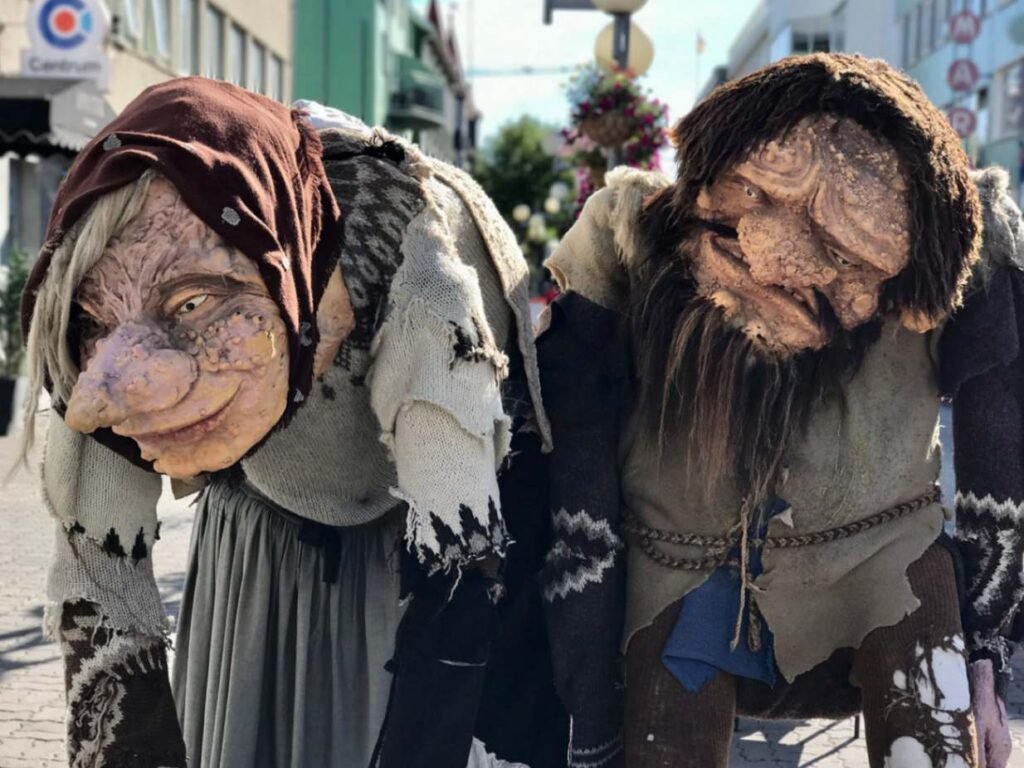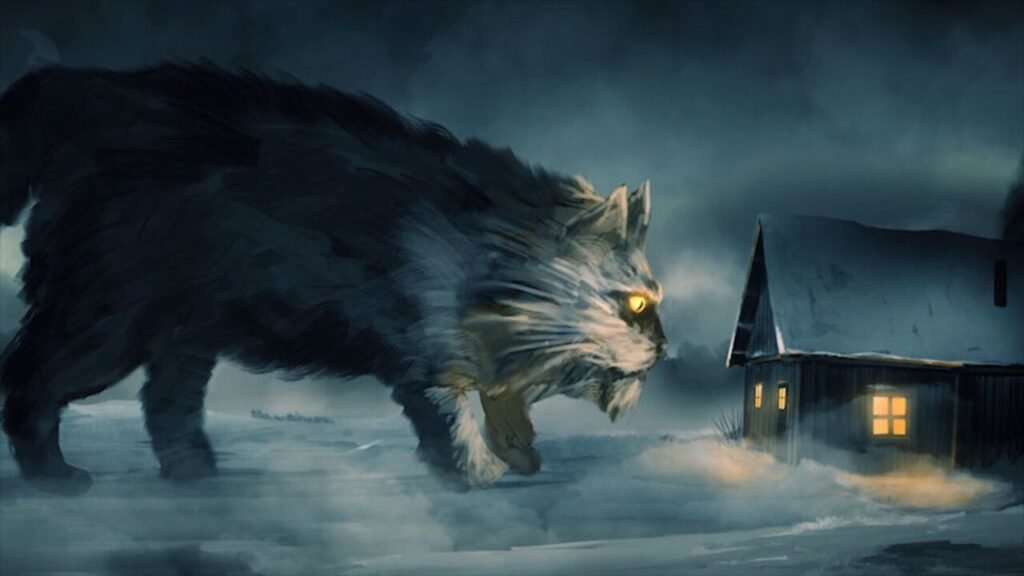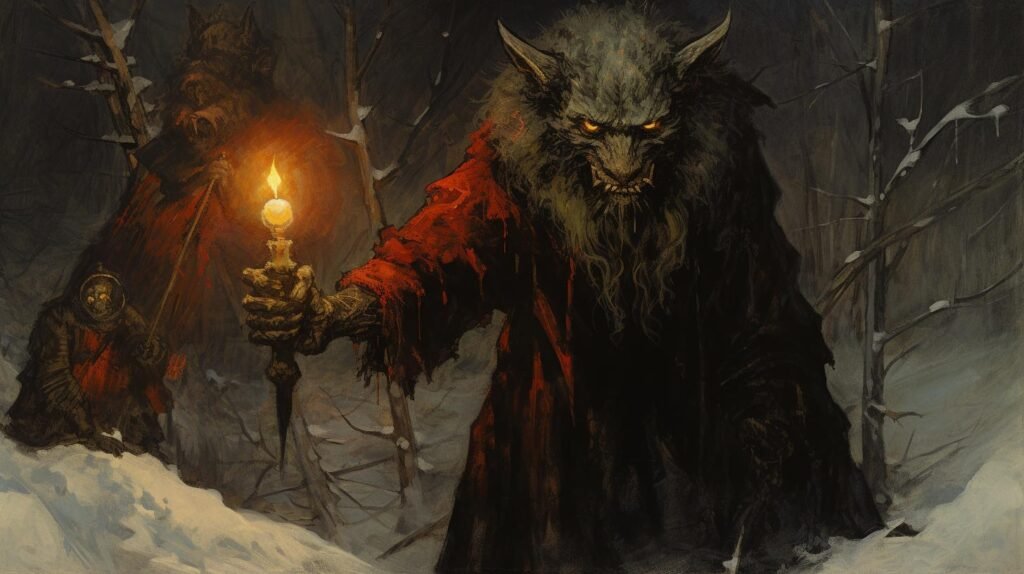Whispered in hushed tones around crackling fires, there exists a world where Christmas isn’t just about cheer and lights. How about Christmas where Krampus – not Santa – reigns supreme, and where Knecht Ruprecht’s stern gaze replaces jolly elves. This journey is an exploration of the chilling, thrilling legends that dance on the fringes of the holiday season, inviting you to discover the darker side of yuletide folklore.
Krampus: The Terrifying Holiday Legend

First of all, let’s talk about Krampus. A figure from Central and Eastern Alpine folklore, is a nightmarish creature that comes to life during the Advent season. This horned, anthropomorphic being is not your typical holiday character. He’s there to scare children who have been naughty, not to spread cheer. Krampus is a stark contrast to the benevolent Saint Nicholas, as he punishes the misbehaved with birch rods, a terrifying reminder to be good.
Mysterious Origins
The origins of Krampus are shrouded in mystery, with some theories tracing him back to pre-Christian Alpine traditions. This sinister figure has been a part of folklore for centuries, evolving over time. Initially, Krampus was a part of pagan rituals and later assimilated into Christian traditions, pairing with St. Nicholas. This blend of pagan and Christian elements makes Krampus a fascinating study of cultural evolution.
Krampus is often depicted as a hairy creature, brown or black, with cloven hooves and horns of a goat. His long, pointed tongue and fangs add to his fearsome appearance. He carries chains, symbolizing the binding of the Devil by the Christian Church. In some tales, he carries a sack or basket on his back to cart off evil children to terrifying fates.
Krampus in Modern Culture
The Krampus tradition, known for its dark themes, is making a comeback. It’s especially popular in Alpine areas and North America. People dress up as Krampus in popular Krampus runs. This figure appears in movies and video games too. His lasting appeal highlights our fascination with the darker side of folklore.
Belsnickel: The Dual-Natured Christmas Figure

Belsnickel, a figure from the folklore of southwestern Germany, is a unique Christmas character. Unlike the jolly Santa Claus, Belsnickel is a crotchety, fur-clad figure who brings a mix of fear and delight to children. He originates from the Palatinate region and is also known in Pennsylvania Dutch and Brazilian-German communities. Belsnickel is intriguing because he embodies both the rewarding and punishing aspects of holiday folklore, typically divided between figures like Saint Nicholas and his companions.
A Figure of Contrasts
Belsnickel is a scruffy man in furs, often with a long-tongued mask. He carries a switch for naughty kids and treats for the good ones. His dual nature is intriguing. He rewards or punishes children based on their actions. Children await him with excitement and nervousness. He knows who’s been naughty or nice.
Spook up your way to Christmas with our Creepy Countdown Calendar; Daily Horror History Facts and Suggestions to frighten up your spirits.
The character of Belsnickel traveled with German immigrants to Pennsylvania, where he became a part of local traditions. He would visit homes before Christmas, creating a sense of fear but also excitement among children. The tradition of Belsnickel has evolved over time and varies from region to region. In some places, he is part of community celebrations, while in others, he remains a more solitary figure.
The Dual Faces of Frau Perchta

Frau Perchta, from Alpine paganism, is both fascinating and scary. She’s part of Upper German, Austrian, and Slovenian Alpine folklore. She appears as a beautiful woman or a decrepit hag. This dual look shows her two sides. She’s kind and cruel during the Twelve Days of Christmas.
A Harsh Enforcer of Cultural Norms
Perchta’s role in folklore is deeply rooted in the enforcement of cultural taboos and societal norms. During the Twelve Days of Christmas, she would visit homes to judge the behavior of children and young servants. Those who had been diligent and well-behaved could expect a reward in the form of a silver coin. However, those who had strayed from the path of good behavior faced a gruesome punishment: Perchta would slit their bellies open, remove their guts, and fill the cavity with straw and pebbles.
A Figure of Myth and Ritual
Perchta’s story is intertwined with various aspects of Alpine culture and tradition. She was particularly concerned with ensuring that girls had completed their allotted spinning tasks. The legend of Perchta also includes her feast day, where she expected adherence to specific dietary restrictions. Her myth is a blend of Germanic and pre-Germanic (likely Celtic) traditions, evolving over time to incorporate various regional variations and names.
Grýla: The Icelandic Giantess of Christmas Lore

Grýla, a figure from Icelandic folklore, is a giantess with a horrifying appetite for misbehaving children. Unlike the jolly figures of Christmas in other cultures, Grýla is a monstrous ogress who keeps a record of children’s misdeeds throughout the year. As Christmas approaches, she descends from the mountains to hunt for her favorite meal: naughty children. Grýla is not just about instilling fear; she’s a part of a family of mythical beings, including her husband Leppalúði and the Yule Lads, her mischievous sons.
A Stew of Naughty Children
Grýla’s legend is particularly gruesome. She doesn’t just eat the children raw; she’s known for making a stew out of them. This aspect of the tale adds a chillingly domestic twist to her character, blending the everyday act of cooking with the macabre. The image of Grýla cooking her stew is a stark reminder of the dark undertones present in many traditional Christmas legends.
Mother of the Yule Lads
Later legends show Grýla as the Yule Lads’ mother. The Yule Lads are 13 pranksters. Each one has their own mischief style. This makes Grýla’s story more complex. She’s more than a monster. She’s the head of a mischievous family.

The Yule Cat: A Fierce Icelandic Christmas Legend
The Yule Cat, known in Icelandic as Jólakötturinn, is a massive and vicious creature from Icelandic Christmas folklore. This cat is no ordinary feline; it’s said to prowl the snowy countryside during the Christmas season, preying on people who haven’t received new clothes before Christmas Eve. The Yule Cat is not just a pet but an integral part of the Icelandic Christmas tradition, closely associated with Grýla, the ogress, and her sons, the Yule Lads.
A Fashion-Driven Predator
The Yule Cat’s unique characteristic is its targeting of individuals based on their fashion – specifically, whether they’ve received new clothes for Christmas. This aspect of the legend is particularly intriguing as it intertwines the idea of reward (new clothes) with the threat of punishment (being eaten by the Yule Cat). It’s a tale that goes beyond mere scare tactics, embedding itself in the cultural practices surrounding clothing and gift-giving during the festive season.
Connection with Grýla and the Yule Lads
While the Yule Cat is a formidable figure in its own right, its association with Grýla and the Yule Lads adds depth to the folklore. This connection paints a picture of a fearsome family, with the Yule Cat as the pet of this mystical and terrifying household. The Yule Cat’s role complements the activities of the Yule Lads and Grýla, creating a comprehensive narrative of Icelandic Christmas traditions that balance fear with festivity.
Knecht Ruprecht: The Stern Companion of Saint Nicholas

Knecht Ruprecht, a character from German folklore, is known as a companion of Saint Nicholas. His role is to accompany Saint Nicholas on his Christmas visits, acting as a foil to the benevolent gift-bringer. Knecht Ruprecht’s appearance is traditionally described as wearing a black or brown robe with a pointed hood, sometimes limping due to a childhood injury, and carrying a long staff and a bag of ashes. He may also wear little bells on his clothes and, in some stories, rides a white horse.
Knecht Ruprecht’s primary task during these visits is to test children on their prayers. If children can pray, they are rewarded with treats like apples, nuts, and gingerbread. However, if they cannot, Ruprecht hits them with his bag of ashes. In other versions of the story, he gives naughty children gifts such as lumps of coal, sticks, and stones, while well-behaving children receive sweets from Saint Nicholas. He is also known to leave a switch (stick) in their shoes for their parents to discipline them, instead of sweets, fruit, and nuts.
Cultural Significance
Knecht Ruprecht first appears in written sources in the 17th century as a figure in a Nuremberg Christmas procession. His character is associated with pre-Christian house spirits (kobold, elf) in Germanic folklore, emphasizing the mischievous side after Christianization. Knecht Ruprecht’s role varies across regions in Germany and is part of a broader tradition of companions of Saint Nicholas in territories formerly in the Holy Roman Empire.
As our exploration of these haunting holiday legends concludes, we are left with a richer understanding of the diverse tapestry of Christmas folklore.
While we revel in the joy and light of Christmas, let’s not forget the intriguing allure of the shadows, in a trip to the Best Horror Festivals around the globe.

